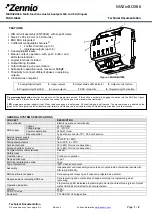
4-3
A. Battery Type
– These are generic lead-acid and Ni-cad battery types.
See Section 8.0 for
more information about battery types and appropriate solar charging.
B. BULK Voltag
e–This is the PWM Absorption stage with constant voltage charging. The
“PWM voltage” is the maximum battery voltage that will be held constant. As the battery
becomes more charged, the charging current tapers down until the battery is fully
charged.
C. Float Voltage
–When the battery is fully charged, the charging voltage will be reduced to
13.4 volts for all battery types.
D. Equalization Voltage
–During an equalization cycle, the charging voltage will be held
constant at this voltage.
E. Equalization Time
–The charging at the selected equalization voltage will continue for
this number of hours. This may take more than one day to complete.
F. Equalization Interval
–Equalizations are typically done once a month. Most of the
cycles are 28 days so the equalization will begin on the same day of the month. It can be
set by Dip Switch 4~6 for different interval days. Each new cycle will be reset as the
equalization starts so that a setting day period will be maintained.
These 8 standard battery charging algorithms will perform well for the majority of solar
systems. However, for systems with specific needs beyond these standard values, any or all
of these values can be adjusted using the potentiometers VR2 and VR1.
4.3 Temperature Effects
4.3.1 Battery Temperature Sensor (BTS)
The BTS is used for temperature compensated battery charging. As the battery gets warmer,
the gassing increases. As the battery gets colder, it becomes more resistant to charging.
Depending on how much the battery temperature varies, it may be important to adjust the
charging for temperature changes.
There are three battery charging parameters that are affected by temperature:
PWM Absorption
This is the most important part of charging that is affected by temperature because the
charging may go into PWM absorption almost every day. If the battery temperature is
colder, the charging will begin to regulate too soon and the battery may not be recharged
with a limited solar resource. If the battery temperature rises, the battery may heat and gas
too much.
Equalization
A colder battery will lose part of the benefit of the equalization. A warmer battery may heat
and gas too much.
















































